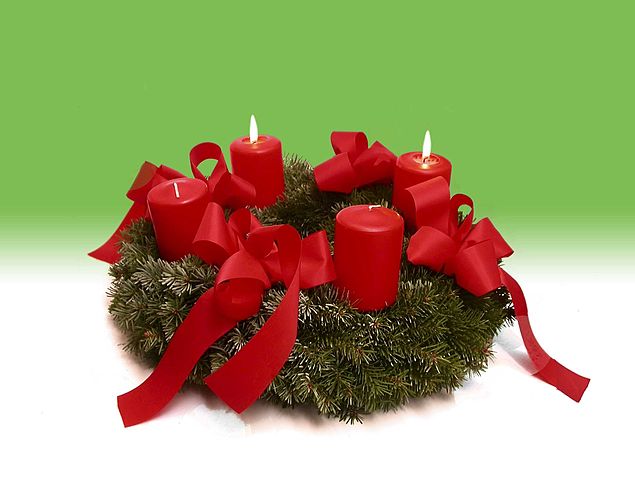
Photo: Clemens PFEIFFER, Vienna (Wikimedia Commons)
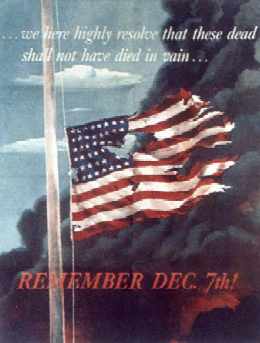
On this date in 1941, Japan launched a carrier based strike on U.S. military forces based in Pearl Harbor, Hawaii. Their strategy was to use this attack to convince the country and its leaders that war with Japan would be futile. They achieved tactical surprise as no warning of an attack had yet been received. While decryption of their codes had revealed their intent, the warning did not reach Pearl Harbor until after the attack had begun. The Japanese legation in Washington did not deliver their government’s official response to a recent diplomatic exchange until after the attack due to problems in transcribing the message. The attack began at 07:55 local time (12:55 p.m. eastern standard time). It was early afternoon when President Roosevelt was notified by Secretary of War Henry Stimson of the attack. There was some doubt among some staff as to the validity of the report but President Roosevelt believed it. And subsequent reports would show it was true. Radio was soon reporting on it as well and the entire nation soon learned of the shocking event that had taken place in the faraway location.
The purpose of the attack was to seriously cripple the U.S. naval and air operations (both the Navy and Army Air Corps). The surprise was effective and sank or crippled numerous American ships. However the jewels of the fleet were the aircraft carriers and they were not there. And the Japanese had no idea where they were. After conducting the first two strikes, a third strike was considered to more completely wipe out the storage, maintenance and dry dock facilities. Captain Minoru Genda, who helped in the planning, argued for invasion to maximize American losses. Admiral Nagumo decided to retire because of deteriorating weather, the unknown location of the American carriers, the long turnaround time required for a third strike that would allow American forces to gather and counterattack, and the fact the Nagumo’s strike force was at the extreme limit of logistical support. They were low on fuel and another strike would require them to travel at reduced speeds to conserve fuel. So he headed home. Much later Admiral Yamamoto, who supported the decision at the time, would in retrospect say it was a mistake since it allowed the U.S. to come back quickly.
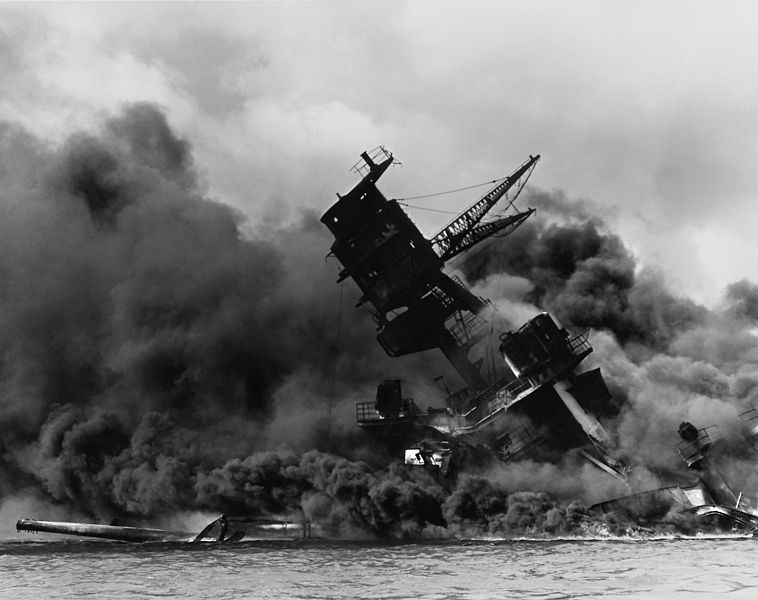
Most of those who died at Pearl were sailors aboard the ships that were damaged or sunk. Of the 2,008 sailors killed, 1,177 were killed when the forward magazine on the USS Arizona exploded. Eighteen ships were sunk, beached, or run aground. 188 aircraft (mostly Army Air Corps) destroyed, 159 damaged. Most of the planes were destroyed on the ground. Only eight pilots got airborne and did attack Japanese aircraft but only one was shot down. Some pilots were killed or shot down later by friendly fire. Five inbound planes from USS Enterprise were shot down. The Navy lost 24 of its PBY planes. Additional casualties came from when Japanese attacked barracks. 2,403 Americans killed and 1,178 others were wounded. Since the U.S. was not at war, they are all classified as non-combatants. The Japanese lost 55 airmen, nine submariners and one captured. They lost 29 planes in battle and 74 were damaged by antiaircraft fire.
Most Americans were enjoying a pleasant Sunday. Secretary of State Cordell Hull met with the Japanese ambassador around 2:30 p.m., just when the first reports were coming in about the attack. Popular Sunday afternoon radio shows were interrupted with the stunning news about the attack on Pearl Harbor. From coast to coast, Americans were riveted to their radios listening to the latest updates. Lines of volunteers began forming outside military recruitment centers. The isolationist sentiment was ushered to the rear while most of the nation united against the Japanese. On 8 November before a joint session of Congress, President Roosevelt asked for a declaration of war.
Mr. Vice President, Mr. Speaker, members of the Senate and the House of Representatives:
Yesterday, December 7th, 1941 – a date which will live in infamy – the United States of America was suddenly and deliberately attacked by naval and air forces of the Empire of Japan.
The United States was at peace with that nation, and, at the solicitation of Japan, was still in conversation with its government and its Emperor looking toward the maintenance of peace in the Pacific.
Indeed, one hour after Japanese air squadrons had commenced bombing in the American island of Oahu, the Japanese Ambassador to the United States and his colleague delivered to our Secretary of State a formal reply to a recent American message. And, while this reply stated that it seemed useless to continue the existing diplomatic negotiations, it contained no threat or hint of war or of armed attack.
It will be recorded that the distance of Hawaii from Japan makes it obvious that the attack was deliberately planned many days or even weeks ago. During the intervening time the Japanese Government has deliberately sought to deceive the United States by false statements and expressions of hope for continued peace.
The attack yesterday on the Hawaiian Islands has caused severe damage to American naval and military forces. I regret to tell you that very many American lives have been lost. In addition, American ships have been reported torpedoed on the high seas between San Francisco and Honolulu.
Yesterday the Japanese Government also launched an attack against Malaya.
Last night Japanese forces attacked Hong Kong.
Last night Japanese forces attacked Guam.
Last night Japanese forces attacked the Philippine Islands.
Last night the Japanese attacked Wake Island.
And this morning the Japanese attacked Midway Island.
Japan has therefore undertaken a surprise offensive extending throughout the Pacific area. The facts of yesterday and today speak for themselves. The people of the United States have already formed their opinions and well understand the implications to the very life and safety of our nation.
As Commander-in-Chief of the Army and Navy I have directed that all measures be taken for our defense, that always will our whole nation remember the character of the onslaught against us.
No matter how long it may take us to overcome this premeditated invasion, the American people, in their righteous might, will win through to absolute victory.
I believe that I interpret the will of the Congress and of the people when I assert that we will not only defend ourselves to the uttermost but will make it very certain that this form of treachery shall never again endanger us.
Hostilities exist. There is no blinking at the fact that our people, our territory and our interests are in grave danger.
With confidence in our armed forces, with the unbounding determination of our people, we will gain the inevitable triumph. So help us God.
I ask that the Congress declare that since the unprovoked and dastardly attack by Japan on Sunday, December 7th, 1941, a state of war has existed between the United States and the Japanese Empire.
President Franklin D. Roosevelt Signing Declaration of War Against Japan 8 Dec 1941
National Archives and Records Administration
And a hour later Congress officially declared war on Japan. Far from causing the U.S. to cower, it brought Americans together like never before. Hitler’s decision to join with Japan on 11 Dec was somewhat of a surprise-to his German High Command! They had not planned with war with the United States so soon and now they faced a two front war with an highly industrialized power against them. Mussolini foolishly committed Italy to the war with the U.S. as well.
For Japan they had control of the Pacific until June 1942. That is when the U.S. Navy engaged the Japanese at the Battle of Midway. At the end of the battle, four Japanese aircraft carriers were sunk to our one (the Yorktown). It was a shocking loss to the Japanese (and one they kept secret for as long as possible). The Doolittle Raid had convinced them to take on the American Navy directly. They did and lost spectacularly. And it shifted the balance of power in the Pacific. Admiral Yamamoto had been correct in his assessment of how the war with America would go:“I shall run wild considerably for the first six months or a year, but I have utterly no confidence for the second and third years.”
Yamamoto would not survive the war. President Roosevelt ordered that he be taken care of for his part in planning the Pearl Harbor attack. Thanks to the work of U.S. Naval Intelligence that had broken Japanese codes (code named Magic), his travel plans to the South Pacific in April, 1943 were learned. Orders were given and select pilots were used to target a very important high officer but were not told who it was. On 18 April 1943, a squadron of Lockheed P-38’s were assigned to intercept and bring down his transport being escorted by Japanese zeroes. There were two Japanese transports. After a dogfight with the Zeroes and transports, the transport with Yamamoto’s plane crashed into the jungle north of Buin, Papua New Guinea. Japanese search parties found his body, thrown from the aircraft and under a tree. He had two .50 caliber bullet wounds, one in his left shoulder and the other that had exited through his right eye. The true manner of his death was hidden from the Japanese public and not revealed until long after the war had ended. He was cremated, given a state funeral, and given posthumous titles and awards. Today the place where his plane crashed is a tourist attraction.
Sources:
“Pearl Harbor: Attack, Deaths and Facts.” HISTORY, 29 Oct. 2009, www.history.com/topics/world-war-ii/pearl-harbor.
“Pearl Harbor Attack | Date, History, Map, Casualties, Timeline, and Facts.” Encyclopedia Britannica, 1 Dec. 2023, www.britannica.com/event/Pearl-Harbor-attack.
“Pearl Harbor Attack, December 7, 1941 | the National WWII Museum | New Orleans.” The National WWII Museum | New Orleans, 7 Dec. 2001, www.nationalww2museum.org/war/topics/pearl-harbor-december-7-1941.
“Pearl Harbor Attack.” Naval History and Heritage Command, www.nationalww2museum.org/war/topics/pearl-harbor-december-7-1941.
Accessed 4 Dec. 2023.
For more information:
Home of Heroes
Pearl Harbor Remembered
The History Place
Pearl Harbor Attack(Naval Heritage & History Command)
Battleship USS Arizona History
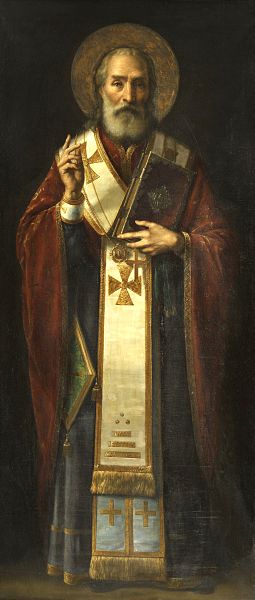
Today is the feast of St. Nicholas, the basis for what has become known as Santa Claus. He was born in the third century to a wealthy family in the village of Patara (now located on the southern coast of Turkey). At the time the area was mostly Greek. While he was young, his parents died during an epidemic. Raised as a Christian, he believed in obeying Jesus in giving his inheritance to those in need. He dedicated his life to serving God and was made Bishop of Myra was still quite young. He earned a reputation for being generous to those in need, his love for children, and concern for sailors and ships.
During the rule of the Roman Emperor Diocletian, Christians were ruthlessly persecuted, and Nicholas suffered for his faith by being exiled and imprisoned. Despite all of the hardship he endured, he never wavered in his faith. He was released and attended the Council of Nicaea in 325 AD. He died on 6 December 343 AD in Myra and was buried. The anniversary of his death would become a celebration and still celebrated to this day (it is 19 December on the Julian calendar used by Eastern Orthodox churches).
His generous deeds and miracles attributed to him spread during the Middle Ages. Many sailors claimed him as a patron and told of him when they traveled. Churches dedicated to Nicholas appeared in many seaport cities. His name spread both east and west making him a very popular saint with many churches named after him in Austria, Belgium, England, Italy, Russia, and Switzerland to name a few. His tomb became popular to visit but concerns over wars in the area cutting off access worried many. In 1087 sailors from Bari were able to retrieve his relics and bring them back. A church was built over his crypt so that pilgrims could visit. The shrine to St. Nicholas in Bari became a major pilgrimage center during medieval Europe. People still visit the shrine today at the Basilica di San Nicola in Bari.
The Roman Catholic Church, Eastern Orthodox, Greek Orthodox, Anglican, and Lutheran churches all have his feast day on their calendars. His generosity and compassion are seen as a model of Christian life. There is some confusion generated about how saint feasts days are celebrated in the Catholic church. Since there quite a number of saints with feasts, it was decided that some saint feast days would be optional for a diocese to celebrate. Saint Nicholas became one of them. He was not stripped of his sainthood. In a diocese where he is popular, has churches or schools named after him, or perhaps the bishop believes he is model to be held up for veneration, his feast day will be celebrated. His feast day is celebrated throughout Europe and in Russia and children receive gifts on the day. Saint Nicholas’ feast day is usually the start of the Christmas season in Europe and elsewhere.
Saint Nicholas and Santa Claus
Saint Nicholas did not fare well during the Protestant Reformation. Saints, even revered ones, were removed to focus on Jesus. Some went so far as to nearly ban any public display of traditional religious customs related to saints or even Christmas (it was not a holiday for that reason in areas that groups like the Puritans dominated). Martin Luther wanted to shift the focus of Christmas to Jesus. The problem was that you cannot have a baby delivering gifts to children as Saint Nicholas did. He came up with the Christkind, a children’s gift giver. This angel, depicted as young girl, brings the gifts when the children are not present. In Nuremberg, the Christkind is selected every two years by vote and between the ages of 16-19. The Christkind opens the Christmas market. She also has her picture taken with kids, listens to what they want, visits kids in hospitals and the elderly as well amongst many other duties. The Christkind was also adopted by many German Catholics as well and spread into Latin America as well. In some cases, both the Christkind and Saint Nicholas deliver presents together.
Despite attempts to diminish Saint Nicholas using the Christkind, he remained popular except in England where many Christmas folk traditions were altered (especially under the rule of the Puritans and Oliver Cromwell). Puritans in America (and some others as well) forbade celebrating Christmas. German immigrants brought celebrating Christmas with them along with Saint Nicholas as well. It was believed the Dutch had brought Saint Nicholas to America, but recent scholarship indicates that was not likely (it is not mentioned in letters or records from the Dutch who lived in New Amsterdam at the time). It appears a series of fictional stories about Saint Nicholas (described as a jolly man with a clay piper) being celebrated by the early Dutch may have been the source.
The 19th century was one of change in America regarding Christmas-and elsewhere as well. Since it was not a sacred or public holiday in many places, it was not the time of carols and goodwill we think about today. Instead, it was a was a rowdy holiday where many got wildly drunk, gambled, and got riotous in some cases threatening people. In England, the Father Christmas figure was about adult merriment and feasting and had nothing to do with children. The actual celebration of Christmas seemed to be fading until books were published depicting Christmas as a time for family, children and faith were published in the 19th century. Washington Irving’s The Sketchbook of Geoffrey Crayon (1819) depicted the celebration of Christmas in England as a warm holiday where peasants were invited into the home to celebrate the holiday. And stories about a magical gift giver called Sante Claus began to appear. Books such as The Children’s Friend (1821) had a character delivering gifts to children on Christmas Eve. Flying a sleigh and living up north, this Sante Claus would form the basis of what is known today as Santa
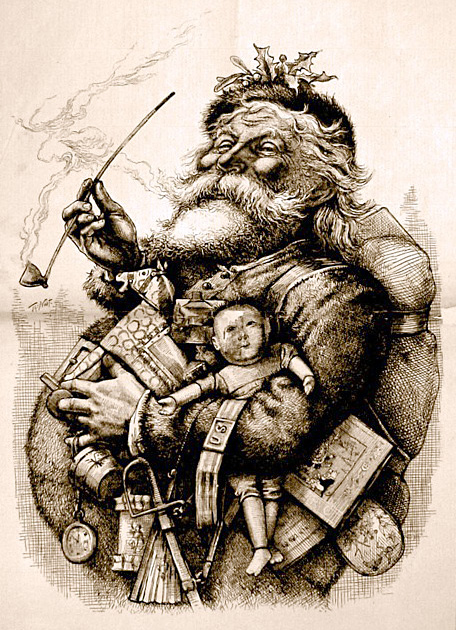
The famous Clement Clark Moore poem A Visit from St. Nicholas would further cement the image of this Sante Claus. Books depicting Christmas began to appear and of course the most famous being A Christmas Carol by Charles Dickens in 1843. This came at a time in Britain when they were re-examining Christmas. This book and others would further help to make Christmas as a time for families, children, and caring about the less fortunate as well. Thomas Nast, the famous political cartoonist, illustrated him as a rotund figure with a beard, fur clothing, and with a clay pipe in 1863. He also changed the name to Santa Claus. His image, with some embellishments and refinements, has remained more or less intact to our time. Christmas was becoming widely celebrated and by 1860 had already been adopted as a state holiday in fourteen states. In 1870, President Grant proclaimed Christmas Day as a federal holiday in the District of Columbia. Congress would pass legislation that made Christmas, New Years, Independence Day and Thanksgiving as federal holidays (remember back then nearly all federal workers were in the District of Columbia). States would also make it a holiday as well.
By the start of the 1930’s, the American Santa had come full form thanks to various illustrators such as Norman Rockwell. Coca-Cola would use Santa in its advertising further establishing his identity in the commercial world. The jolly man with the red suit would be seen in magazines, billboards, shop counters, and greeting cards. A benign source of happiness and seemingly endorsing all kinds of commercial products, he became as American as apple pie (to coin a phrase). His image would spread out to the world competing with local versions (Father Christmas, Pere Noel, Babbo Natale, Sinter Klass, Julenesse etc.) Saint Nicholas still retains his place in Europe despite this.
Many people, seeing Santa as a commercial and pagan creation, are now reclaiming the saint for use in the holiday. Saint Nicholas brings a spiritual emphasis to the holiday, which Santa does not. Some have tried to ban Santa Claus because of his supposed connection to Saint Nicholas, except there is none. One is a revered saint and bishop, the other a complete concoction of writers, illustrators, and marketing departments. There is nothing Christian about Santa Claus. Movies like The Santa Clause, while entertaining, put him into a world of fantasy beings like Mother Nature, Cupid, and the Tooth Fairy. By returning focus to Saint Nicholas, we get closer to what the celebration is about.
Sources:
“Who is-St. Nicholas?” St. Nicholas Center, www.stnicholascenter.org.
Straus, Jacob. “Federal Holidays: Evolution and Current Practices.” Congressional Research Services, R41990, Congressional Research Services, 1 July 2021, https://fas.org/sgp/crs/misc/R41990.pdf. Accessed 4 Dec. 2023.
“A History of Christmas in America.” The Classical Historian, www.classicalhistorian.com/johns-blog/a-history-of-christmas-in-america.
“History of Christmas – Origins, Traditions and Facts | HISTORY.” HISTORY, 27 Oct. 2009, www.history.com/topics/christmas/history-of-christmas.
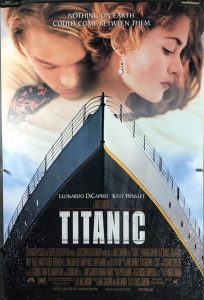
“Largo Man Trying to Collect One Million Copies of Titanic on VHS.” ABC Action News Tampa Bay (WFTS), 29 Nov. 2023, www.abcactionnews.com/news/region-pinellas/largo-man-trying-to-collect-one-million-copies-of-titanic-on-vhs.
Growing up, we probably all had that favorite movie that we could just watch over and over and over again. Well, there’s a man in Largo who has taken his love for his favorite movie to the extreme. Every time JD adds another VHS copy of Titanic to his collection, he feels like he’s the king of the world. “You know, Titanic is best on VHS,” said JD. “’September 1, 1998, take the voyage home,’ that’s what they were saying. That’s what I was playing on the VCR, I was watching this thing over and over and over again.”
There are many who acquire Titanic memorabilia because it is special and unique. But collecting 1 million copies on VHS of Cameron’s Titanic is not just extreme, but what would you do with it. It sort of like that scene in the original Willy Wonka movie. When they guy programs the computer to tell him where he can locate the Wonka bars with the gold certificate inside, it declines saying it would be cheating. When he offers to share the award with the computer, it responds “What would I do with a million bars of chocolate?”
=
“Titanic Returns to Chicago in February 2024.” EIN News, 29 Nov. 2023, www.einnews.com/pr_news/671524148/titanic-returns-to-chicago-in-february-2024.
As the largest and most immersive touring Titanic exhibition, the experience is a narrative journey that brings to light the fates of the passengers and crew aboard the sinking ship, and will open on Friday, February 16, 2024 at Westfield Old Orchard (4963 Old Orchard Road) in Skokie, IL. People can join the waitlist through Fever here to gain access to tickets before they go on sale to the public December 6th. Tickets start at $29.00 for adults, with discounts for kids, seniors, military, and groups.
=
How big is too big? That is the question here. This ship is essentially its own small metropolis that holds up to 10,000 people at a time. It has multiple entertainment venues, food options and so much that is boggles the mind. When you see pictures of it, the enormity of this ship really hits you. Royal Caribbean is proud of this new ship and you can be sure buckets of media will be watching its every move. Not to mention people commenting on social media about their experience.
![]() “World’s Largest Cruise Ship That’s Five Times Bigger Than the Titanic Is About to Make Its First Voyage.” UNILAD, 28 Nov. 2023, www.unilad.com/news/travel/worlds-largest-cruise-ship-sets-sail-royal-caribbean-799666-20231128.
“World’s Largest Cruise Ship That’s Five Times Bigger Than the Titanic Is About to Make Its First Voyage.” UNILAD, 28 Nov. 2023, www.unilad.com/news/travel/worlds-largest-cruise-ship-sets-sail-royal-caribbean-799666-20231128.
The Royal Caribbean ship has been hailed as the world’s largest and is officially five times bigger than The Titanic. The huge vessel is 65 meters long – around 1,200 feet – and weighs in at 250,800 tonnes. Boasting 20 decks, the ship has the largest water park at sea, as well as a section of the boat dedicated just for families. Constructed in Finland, the Icon of the Seas has finally been built and officially joined Royal Caribbean’s fleet yesterday (November 27) ahead of its pending departure. It’s said that the ginormous ship took two and a half years to create (including both design and construction) and will hold almost 10,000 people at a time.
=
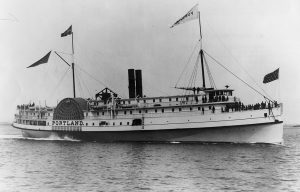
“Those Who Perished 125 Years Ago in Sinking of ‘Maine’s Titanic’ Remembered at Service.” Press Herald, 26 Nov. 2023, www.pressherald.com/2023/11/25/those-who-perished-125-years-ago-in-sinking-of-maines-titanic-remembered-at-anniversary-service.
In Portland’s historical Abyssinian Meeting House, 198 names were read aloud Saturday remembering those who perished 125 years ago in New England’s worst maritime disaster. On the Saturday after Thanksgiving in 1898, at least 68 crew members and 130 passengers boarded the SS Portland in Boston and headed for Portland. They never reached their destination. By the next day, each was gone, swallowed by the sea off Cape Cod during a fierce blizzard.
=
,
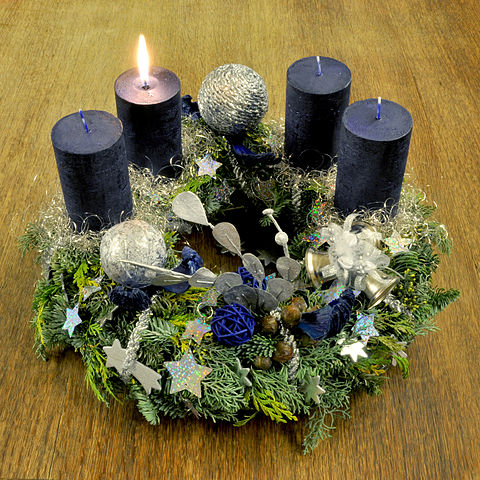
Advent is not just a countdown till Christmas but an important part of the liturgical year in preparation for the birth of Jesus. Roman Catholics, Eastern Orthodox, Anglicans and other Christian denominations observe this special time. Advent is a short period of only four weeks (Sundays and weekdays) leading up to Christmas Day. Usually, Advent begins on or after the feast of St. Andrew the Apostle on 30 November. Eastern Orthodox uses the Julian calendar for their liturgical year, so they start 13 days after the current Gregorian calendar date.
The word Advent comes Latin word adventus, meaning coming or coming to, is a time of preparation for the birth of Christ and a reminder that Jesus will return. Christians are reminded during this period to not be distracted or weighed down by all the commercialization that is going on around Christmas and focus on deepening their relationships with God. For Catholics it will be solemn masses, setting up Advent wreaths, reciting special prayers, and being more concerned about our fellow human beings. There are also special Advent songs and music that are used during this time as well.
Anglicans uses both traditional and modern rituals which include Advent processions, carols, and using Advent calendars (Catholics are doing this as well). Lutherans focus on God’s grace and his redemption. They incorporate Advent hymns, scripture, and lighting Advent candles as well. For Eastern Orthodox, it involves fasting until Christmas Day, daily prayers, and greatly anticipating the important event that is to come.
Whatever the denomination, Christians are preparing themselves for not only the birth of the savior but his return one day (the Final Judgment). So, it is a time of preparation, repentance, faith, and loving our fellow human beings. It also means to seek reconciliation through prayer and going to a priest or minister to get forgiven for our sins. Advent is not a time of merely counting down the clock and buying presents but spending time preparing for this important holy day that is to come. And a time to get closer to God as well.
Sources
Klein, Camilla. “Which Christian Denominations Celebrate Advent? – Christian Educators Academy.” Christian Educators Academy, 26 May 2023, www.christianeducatorsacademy.com/which-christian-denominations-celebrate-advent.
Infoplease. “Advent: Dates, Traditions, and History.” InfoPlease, 18 Nov. 2021, www.infoplease.com/culture-entertainment/holidays/advent-dates-traditions-and-history.
Staff, CNA. “What Is Advent Anyway?” Catholic News Agency, 1 Dec. 2023, www.catholicnewsagency.com/news/42900/what-is-advent-anyway-a-cna-explainer.
—. “The Beautiful Meaning and Purpose of Advent.” Crosswalk.com, 13 Nov. 2023, www.crosswalk.com/special-coverage/christmas-and-advent/the-beautiful-meaning-and-purpose-of-advent.html.
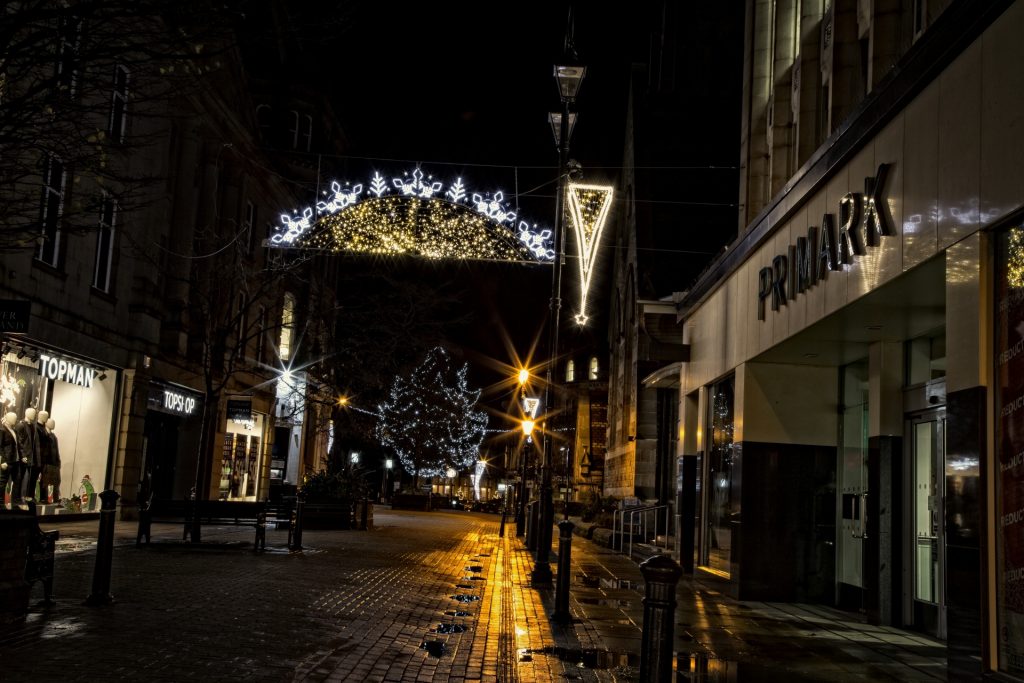
December is the 12th month on the Gregorian calendar. The name derives from the Latin word decem, which means ten. Originally December was the tenth month in an older calendar as it started in March. Apparently the winter days that followed December were not included in a month until much later when January and February were added. December retained its name though. Anglo-Saxons used the term Yule for December-January, but that now that has largely come to mean December and the Christmas season.
December has the winter solstice in the Northern Hemisphere and the summer solstice in the Southern. Winter traditionally begins on the astronomical calendar around 21 December or the date of the actual solstice. The winter solstice is the shortest day of the year and depending on how far north you live, sunlight may only be for a few hours on that day. The symbols for December are the narcissus flower and turquoise, zircon and tanzanite as the birthstones.
Most Christians celebrate Advent in preparation for the celebration of Christmas on 25 December. Jews celebrate Chanukah/Hanukkah, the 8-day Festival of Lights in December as well. Kwanzaa is celebrated from December 26-January 1.